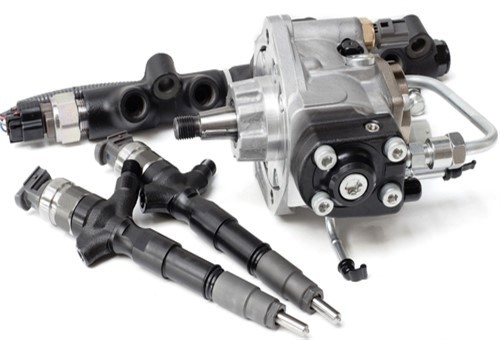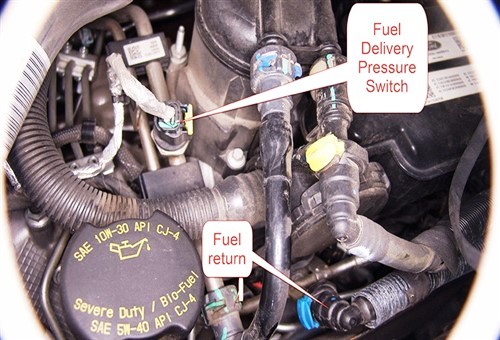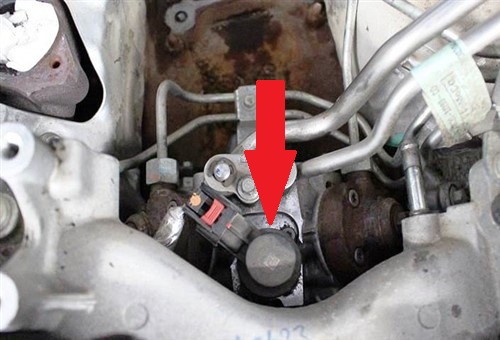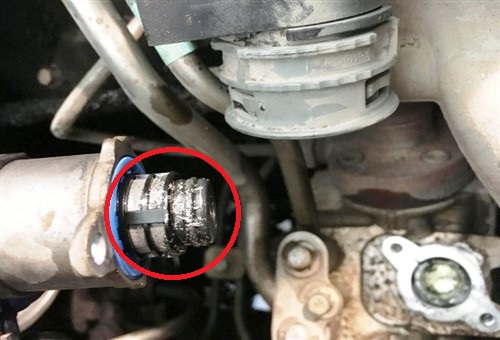
Through either dumb luck or circumstance, this writer had not had a Ford 6.7L Powerstroke engine with a no-start condition in his workshop for several years, until a 2014 F350 truck with just such an engine was recently presented to him by its owner. If you don’t specialise in diesel repairs, you may or may not know that Ford’s Powerstroke diesel engines are not particularly mechanic friendly, which can sometimes make diagnosing some issues, and particularly, no-start issues, on these engines a challenging affair. Nonetheless, because of (or perhaps despite) the fact that none of the staff had had any recent experience with no-start issues on 6.7L Powerstroke engines, it was decided to give the problem our full attention and in this article, we will discuss the diagnostic process in some detail. Let us start with-
According to the owner of the truck, it had been running perfectly until about 300km or so ago when it started misfiring, and became progressively more difficult to start regardless of the engine temperature until it could not be started at all. It is perhaps worth mentioning that the vehicle's owner also noticed a steady increase in the engine oil level, and that he thought the oil had taken on a distinctive diesel-y smell soon after the problem first appeared.
The first workshop he took it to performed an EGR delete and removed all exhaust after-treatment components. This did not fix the no-start issue, so they replaced all fuel filters, which did nothing to improve matters. When replacing the fuel filters the second time also did not resolve the issue, or made any difference, the workshop referred the owner to us.
Our preliminary inspection revealed one defective battery, which we replaced, but despite this the engine cranked but still refused to start, so we connected our Ford-specific scan tool and found the following trouble codes in this order-
These codes clearly indicated fuel supply problems, but since nothing on this engine except the secondary fuel filter is easily accessible, we decided to obtain some freeze frame data* on both the fuel rail pressure and the low-pressure fuel delivery PID’s while cranking the engine. The object of this exercise was to determine whether or not a suitable volume of fuel was being delivered to the CP4 (high-pressure injection) pump on the one hand, and whether or not the CP4 pump was able to build at least some pressure in the fuel rails, on the other. It turned out, however, that neither the low nor the high-pressure systems registered any values at all, which brings us to our-
* Note that the high-side fuel pressure cannot be measured directly on this engine because the fuel rails are not equipped with test ports. The only way to obtain an approximation of the actual pressure in the rail without a scan tool is to disconnect the fuel return line at the indicated location and to use a conventional fuel pressure gauge to measure the pressure in the fuel return line on the engine side. The image below shows the relevant connection point-

Image source: https://www.searchautoparts.com/sites/www.searchautoparts.com/files/images/un-Figure%204.jpg
It is easy to put the cart before the horse in these kinds of situations, so to avoid that, we decided to see how much fuel the low-pressure fuel pump was delivering to the high-pressure fuel pump. Before we get to specifics, however, we need to explain the finer points of this system-
Trouble code P008A sets when the low-pressure fuel delivery switch, which is located inside the high-pressure injection pump’s supply tube, fails to switch between its normally closed state to fully open when the pressure in the low side reaches a minimum threshold of 365 kPa. If the pressure in the system drops below this value, the switch closes and if it stays closed for longer than 60 consecutive seconds the code sets, and a warning light is illuminated on the dashboard.
Therefore, for this system to work, and assuming that the low-pressure fuel pump works as intended, the low-pressure system requires a restriction in the system for the pump to generate any pressure at all, and in this case, the restriction is formed by the low-pressure fuel delivery switch, which opens at a measured pressure of 365 kPa. However, since the freeze frame data showed no pressure at all, it was as likely for the pump to be defective as it was likely for the low-pressure fuel delivery switch to be defective, which required that the pump’s actual delivery rate be tested.
To do this, we disconnected the low-pressure line from the secondary filter and activated the pump with the scan tool. This can also be done simply by turning the key to the “ON” position, which will let the pump run for 30 seconds. Nonetheless, the pump delivered about one litre of diesel fuel in just over 60 seconds, but what was more important was that although the fuel was clean and appeared to be uncontaminated, the fuel was full of air bubbles.
The presence of air bubbles was capable of several interpretations, but to eliminate the possibility of a defective pump we installed an OEM replacement, which solved the air bubble problem. However, according to subsequent live data, there was still no pressure in the low-side system, although the new low-pressure system pump delivered one litre of fuel in less than 15 seconds. Being back at square one, we decided to research the enabling/setting conditions of the other three fault codes. Here is what we found via official Ford sources-
P0087 – Fuel Rail Pressure Too Low
Official Ford sources state “...the PCM regulates the fuel rail pressure by controlling the fuel volume control valve and fuel pressure control valve. This DTC sets when the PCM is no longer capable of maintaining the fuel pressure. [Thus] ..." this DTC sets when the PCM is no longer capable of maintaining the fuel pressure” [in the high-pressure fuel rail].
In translation, this means that the code sets when the required pressure in the fuel rail cannot be established or maintained, even though the fuel volume control valve in the low-pressure system is fully open.
P2291- Low Fuel Pressure During Cranking
Official Ford sources state, “The PCM monitors the fuel rail pressure (FRP) during engine cranking. This DTC sets when the FRP does not increase to the calibrated [minimum] threshold while the engine is cranked”*.
* This is a code that indicates a symptom, as opposed to indicating the failure of a specific part or component.
P0093 – Fuel System Large Leak
Again, official Ford sources state, “This DTC sets when the requested fuel volume control value exceeds a calibrated threshold indicating a large fuel system leak”.
Armed with this knowledge, we concluded that even though the old low-pressure pump may not have been in a perfect condition, the problem did not involve the low-pressure side of the fuel system, since fitting a new pump did not change anything in meaningful ways.
We also concluded that since the hydraulic principle requires a restriction in the system for the system to build and maintain pressure, the absence of pressure in the high-pressure side was caused by one of two things. The first was a large internal leak in the high-pressure side, and the other was the absence of a restriction in the low-pressure side, such as might be expected when a rail-mounted fuel pressure regulator fails.
However, since an examination of the fuel rails showed that this system did not have anything resembling a conventional fuel pressure regulator, we started-
Any fuel injection system has to have some way of relieving excess pressure, but since we could not immediately find the pressure-relieving mechanism on this engine, we purchased a schematic drawing of the fuel supply circuit(s), and it turned out that the pressure relief valve is incorporated into the CP4 high-pressure injection pump. The image below shows exactly where on the pump, what, in Ford-speak, is called an “overflow valve”, is located-

This view is from the top, looking straight down. However, to get the same view of the “overflow valve”, it is necessary to remove almost all of the intake system, which takes about two hours or so.
Nevertheless, this electronically controlled solenoid controls the flow of fuel through internal passages in the pump, in much the same way that oil control solenoids control the actuators in variable valve/cam mechanisms. In practice though, this valve is nothing more than a spring-operated relief valve, which is pulled open against spring tension by the solenoid spindle when the solenoid is energised.
To test this valve we applied a current to it and it clicked audibly, which meant that the solenoid was working. The next step was to remove it from the pump and to inspect its screen for signs of collected gunk and debris, on the assumption that if the screen was blocked even partially, the CP4 pump might be deprived of the correct volume of fuel. On the other hand, if the valve was stuck in the open position, the fuel on the low-pressure side will simply be passed back to the fuel tank through the return line, which brings us to-
At this point, we removed the overflow valve and saw this-

Image source: https://www.ford-trucks.com/forums/1559704-hp-fuel-pump-bites-the-dust.html
Whether or not the overflow valve worked became moot when we saw the metal debris on the screen. We all knew that something in the fuel system had failed catastrophically, but since none of us was an expert on CP4 high-pressure injection pumps, and we were not about to dismantle the pump, we consulted both official Ford sources and some local specialist diesel repairers. Here is what we learned-
It turned out that the presence of metal debris on the overflow valves’ screen was unequivocal evidence that the CP4 pump had failed in the worst possible way. It also turned out that CP4 pumps were designed to run with European diesel, which contains more sulphur than diesel fuels found elsewhere in the world. Thus, since the role of sulphur in diesel fuel is to act as a super-lubricant, the low sulphur content of local diesel deprived the pump of its primary source of lubrication, which explains the high incidence of CP4 pump failures at around the 150 000km mark almost everywhere in the world except Europe, which brings us to-
There was more bad news though. We also learned that once a CP4 pump starts to shed metal particles, the design of the high-pressure fuel system allows debris to spread throughout not only the high-pressure side and into the injectors, but also throughout the low-pressure side. Some more research followed, and we learned that the only reliable remedy for this situation is to remove the fuel tank and the entire low-pressure system and to have everything in this system cleaned and purged to remove all debris.
Moreover, since the CP4 pump is damaged beyond repair, it has to be replaced along with the injectors, because there is no reliable way to repair the damage to injectors caused by metal debris in the fuel. Ford service information also recommended that all high-pressure fuel lines be replaced to avoid leaks that require removal of the intake system to repair.
Later that day we presented our findings to the customer, who, perhaps predictably, declined to have the vehicle repaired because the estimated repair costs using rebuilt components amounted to an unpalatable percentage of the vehicle's retail value. We might mention that our repair cost estimate excluded the cost of restoring both the EGR and exhaust after-treatment systems.
Although the customer did pay us for the new low-pressure pump we installed, and the time we spent finding the problem this episode taught us much about the fuel injection systems on Ford’s 6.7L Powerstroke engines in general, and even more about the CP4 high-pressure injection pumps, in particular.
More specifically though, we know that although fuel quality and cleanliness is a critical aspect of how well, or otherwise modern common rail diesel injection systems work, we learned that this aspect of diesel fuel is even more critical on systems that use CP4 injection pumps. However, while the several fuel samples we had taken from this vehicle were all clean and free of visible contamination, we did not consider the possibility that the fuel might be deficient in sulphur, which in the final analysis, was the principal reason why the CP4 injection pump had failed so catastrophically.
Although adding of a litre or so of sulphur-rich ASTM-quality biodiesel to each tank of fuel might alleviate the lubricity problems of ultra-low sulphur diesel, it should be remembered that biodiesel creates more oxides of nitrogen during combustion than regular diesel does. Therefore, adding biodiesel to protect CP4 injection pumps could have negative effects on the long-term efficiency and longevity of catalytic converters, and especially on converters and DPF devices in SCR-based exhaust after-treatment systems.
Thus, it seems that that the best advice we can offer our customers who have CP4 injection pumps on their vehicles is for them to always use diesel fuel with the highest sulphur content available- sulphur seemingly being the only thing that can save CP4 pumps from destruction after about 150 000km of use.